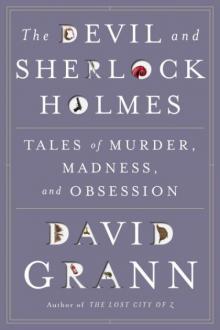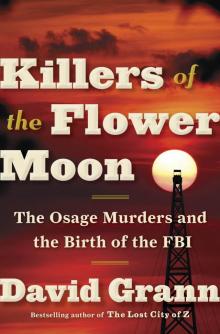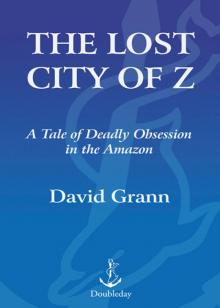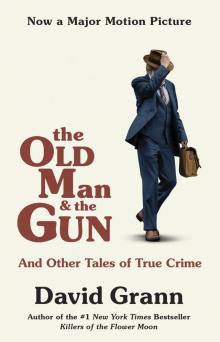- Home
- David Grann
Killers of the Flower Moon Page 14
Killers of the Flower Moon Read online
Page 14
White suspected that Hale had ginned up the document while trying to obtain the insurance policy, and altered it after realizing that he had blundered on the date. Later, a federal official questioned the man who Hale claimed had typed up the note. He denied ever having seen the document. Asked if Hale was lying, he said, “Absolutely.”
The second insurance company approved the policy after Hale took Roan to the Pawhuska doctor again for the required medical examination. The doctor recalled asking Hale, “Bill, what are you going to do, kill this Indian?”
Hale, laughing, said, “Hell, yes.”
After Hale served as a pallbearer at Roan’s funeral, White learned, local lawmen did more than ignore Hale as a suspect: they tried to build a case against Roy Bunch, the man who’d been having an affair with Roan’s wife. White and his agents spoke to Bunch, who maintained his innocence and told a curious story about Hale. After Roan’s murder, Hale had approached Bunch and said, “If I were you, I’d get out of town.”
“Why should I run? I didn’t do it.”
“People think you did,” Hale said.
He offered Bunch money to help him flee. Afterward, Bunch spoke to a friend, who persuaded him not to take off, because it would only make him look guilty. “If you run, they’ll hang it on you for sure,” his friend said.
White and his men thoroughly investigated Bunch and ruled him out as a suspect; as one agent noted, the “notorious relations between Bunch and Roan’s wife were calculated to furnish a good screen” for the real murderers. And the person who seemed most intent on framing Bunch was the King of the Osage Hills. After Roan’s murder, Hale had visited Roan’s widow several times to try to get her to sign various papers regarding claims against Roan’s estate. Once, Hale had left a bottle of whiskey for her as a gift. But she refused to taste the moonshine: she feared that it was poisoned.
Though White had gathered circumstantial evidence implicating Hale in the murder of Roan, there were still huge holes in the case. There was no proof—no fingerprints, no credible eyewitnesses—that Hale had shot Roan or that he had ordered one of his nephews or another henchman to do so. And while the suspicious life-insurance policy seemed to tie Hale to Roan’s murder, it did not provide a motive for the other Osage killings.
Yet, as White studied the Roan case further, one detail stood out. Before Hale obtained the life-insurance policy on Roan, he had attempted to purchase Roan’s headright—his share in the tribe’s mineral trust, which was more precious than any cache of diamonds or gold. Hale knew that the law prevented anyone from buying or selling a headright, but he’d been confident that lobbying pressure from influential whites would soon eliminate this prohibition. Indeed, Hale once said, “I, like many other good men, believed it would be only a short time until Congress would pass a law permitting every educated Indian who had his certificate of competency to sell or convey his or her mineral rights to whom they wished.” Yet the law had not been changed, and White suspected that this setback had prompted Hale to turn to the insurance murder plot.
There was one legal way, though, that someone could still obtain a headright: inheritance. As White examined probate records for many of the murder victims, it was evident that with each successive death more and more headrights were being directed into the hands of one person—Mollie Burkhart. And it just so happened that she was married to Hale’s nephew Ernest, a man who, as an agent wrote in a report, “is absolutely controlled by Hale.” Kelsie Morrison, the bootlegger and bureau informant, said to agents that both Ernest and Bryan Burkhart did exactly what their uncle told them to do. Morrison added that Hale was “capable of anything.”
White studied the pattern of deaths in Mollie’s family. Even the chronology no longer seemed haphazard but was part of a ruthless plan. Anna Brown, divorced and without children, had bequeathed nearly all her wealth to her mother, Lizzie. By killing Anna first, the mastermind made sure that her headright would not be divided between multiple heirs. Because Lizzie had willed most of her headright to her surviving daughters, Mollie and Rita, she became the next logical target. Then came Rita and her husband, Bill Smith. White realized that the unusual method of the final killing—a bombing—had a vicious logic. The wills of Rita and Bill stipulated that if they died simultaneously, much of Rita’s headright would go to her surviving sister, Mollie. Here, the mastermind had made one miscalculation. Because Bill unexpectedly outlived Rita by a few days, he had inherited much of her wealth, and upon his death the money went to one of his relatives. Still, the bulk of the family’s headrights had been funneled to Mollie Burkhart, whose wealth was controlled by Ernest. And Hale, White was convinced, had secretly forged an indirect channel to this fortune through his subservient nephew. As White later reported to Hoover, “MOLLIE appears to have been the first means to draw HALE, through the BURKHARTS, the assets of the entire family.”
White couldn’t determine whether Ernest’s marriage to Mollie—four years before Anna’s murder—had been conceived from the outset as part of the plot, or if Hale had prevailed upon his nephew to betray her after they married. In either case, the plan was so brazen, so sinister, that it was hard to fathom. It demanded that Ernest share a bed with Mollie, and raise children with her, all while plotting and scheming against her family. As Shakespeare wrote in Julius Caesar:
Where wilt thou find a cavern dark enough
To mask thy monstrous visage? Seek none, conspiracy:
Hide it in smiles and affability.
Ernest and Mollie Burkhart Credit 47
16 FOR THE BETTERMENT OF THE BUREAU
White and his men felt a growing sense of progress. A Justice Department prosecutor sent Hoover a note, saying that in the few months since White had assumed command of the investigation, “many new angles of these cases were successfully developed” and a “new and enthusiastic spirit seemed to pervade the hearts of all of us.”
Still, White faced the same problem with the investigation of Mollie Burkhart’s murdered family that he did with his inquiry into Roan’s death. There was no physical evidence or witnesses to prove that Hale had carried out or ordered any of the killings. And without an airtight case White knew that he’d never be able to bring down this man who hid behind layers of respectability—who called himself the Reverend—and who used a network of patronage to influence the sheriff’s office, prosecutors, judges, and some of the highest state officials.
In a stark report, agents noted that Scott Mathis, the Big Hill Trading Company owner and a guardian of Anna Brown and Lizzie, was “a crook and evidently in the power of Hale”; that an associate of Mathis’s served as a “spy for Bill Hale and the Big Hill Trading Company, and does all the framing for them in their crooked deals in skinning the Indians”; that the chief of police in Ponca City had “taken money from Bill Hale”; that the chief of police in Fairfax “will do nothing against Hale whatsoever”; that a local banker and guardian “will not talk against the Hale faction, for the reason that Hale has too much on him”; that the mayor of Fairfax, “an arch crook,” was Hale’s close friend; that a longtime county prosecutor was part of Hale’s political machine and was “no good” and “crooked”; and that even a federal official with the Office of Indian Affairs was “in the power of Bill Hale and will do what Hale says.”
White realized that his struggle to obtain justice was just beginning. As a bureau report would put it, Hale “dominated local politics and seemingly could not be punished.” Hoover had earlier praised White, saying that because of his handling of the case “conditions have been peaceful and I have had no complaint or criticism whatsoever, and this has been a great relief to me.” Yet Hoover—that “slender bundle of high-charged electric wire,” as one reporter described him—was growing increasingly impatient.
Hoover wanted the new investigation to be a showcase for his bureau, which he had continued to restructure. To counter the sordid image created by Burns and the old school of venal detectives, Hoover adopted the approa
ch of Progressive thinkers who advocated for ruthlessly efficient systems of management. These systems were modeled on the theories of Frederick Winslow Taylor, an industrial engineer, who argued that companies should be run “scientifically,” with each worker’s task minutely analyzed and quantified. Applying these methods to government, Progressives sought to end the tradition of crooked party bosses packing government agencies, including law enforcement, with patrons and hacks. Instead, a new class of technocratic civil servants would manage burgeoning bureaucracies, in the manner of Herbert Hoover—“the Great Engineer”—who had become a hero for administering humanitarian relief efforts so expeditiously during World War I.
As the historian Richard Gid Powers has noted, J. Edgar Hoover found in Progressivism an approach that reflected his own obsession with organization and social control. What’s more, here was a way for Hoover, a deskbound functionary, to cast himself as a dashing figure—a crusader for the modern scientific age. The fact that he didn’t fire a gun only burnished his image. Reporters noted that the “days of ‘old sleuth’ are over” and that Hoover had “scrapped the old ‘gum shoe, dark lantern and false moustache’ traditions of the Bureau of Investigation and substituted business methods of procedure.” One article said, “He plays golf. Whoever could picture Old Sleuth doing that?”
Yet an ugliness often lurked beneath the reformist zeal of Progressivism. Many Progressives—who tended to be middle-class white Protestants—held deep prejudices against immigrants and blacks and were so convinced of their own virtuous authority that they disdained democratic procedures. This part of Progressivism mirrored Hoover’s darkest impulses.
As Hoover radically streamlined the bureau, eliminating overlapping divisions and centralizing authority, White, like other special agents in charge, was given greater command over his men in the field, but he also became more accountable to Hoover for anything the agents did, good or bad. White had to constantly fill out Efficiency Rating sheets, grading agents, on a scale of 0 to 100, in such categories as “knowledge,” “judgment,” “personal appearance,” “paper work,” and “loyalty.” The average score became an agent’s overall grade. After White told Hoover that he had occasionally given an agent a 100 rating, Hoover responded sharply, writing, “I regret that I am unable to bring myself to believe that any agent in the jurisdiction of the Bureau is entitled to a perfect or 100% rating.”
Hoover, who believed that his men should conquer their deficiencies the way he had conquered his childhood stutter, purged anyone who failed to meet his exacting standards. “I have caused the removal from the service of a considerable number of employees,” he informed White and other special agents. “Some have been lacking in educational ability and others have been lacking in moral stamina.” Hoover often repeated the maxim “You either improve or deteriorate.”
Though Hoover conceded that some might deem him a “fanatic,” he reacted with fury to any violations of the rules. In the spring of 1925, when White was still based in Houston, Hoover expressed outrage to him that several agents in the San Francisco field office were drinking liquor. He immediately fired these agents and ordered White—who, unlike his brother Doc and many of the other Cowboys, wasn’t much of a drinker—to inform all of his personnel that they would meet a similar fate if caught using intoxicants. He told White, “I believe that when a man becomes a part of the forces of this Bureau he must so conduct himself as to remove the slightest possibility of causing criticism or attack upon the Bureau.”
The new policies, which were collected into a thick manual, the bible of Hoover’s bureau, went beyond codes of conduct. They dictated how agents gathered and processed information. In the past, agents had filed reports by phone or telegram, or by briefing a superior in person. As a result, critical information, including entire case files, was often lost.
Before joining the Justice Department, Hoover had been a clerk at the Library of Congress—“I’m sure he would be the Chief Librarian if he’d stayed with us,” a co-worker said—and Hoover had mastered how to classify reams of data using its Dewey decimal–like system. Hoover adopted a similar model, with its classifications and numbered subdivisions, to organize the bureau’s Central Files and General Indices. (Hoover’s “Personal File,” which included information that could be used to blackmail politicians, would be stored separately, in his secretary’s office.) Agents were now expected to standardize the way they filed their case reports, on single sheets of paper. This cut down not only on paperwork—another statistical measurement of efficiency—but also on the time it took for a prosecutor to assess whether a case should be pursued.
Tom White and Hoover Credit 48
White himself could be a demanding superior. An agent who worked under him in Oklahoma recalled that each of his men was “supposed to know his job and do it.” Another man who later worked under White said he could be “honest till it hurt.” Yet White was more forgiving of frailty than Hoover was, and he often tried to shield his men from the boss man’s anger. When Hoover became inflamed after one of White’s agents failed to use the one-page format in a report on the Osage murder cases, White told Hoover, “I feel that I, myself, am altogether to blame for I looked over this report and gave it my approval.”
Under Hoover, agents were now seen as interchangeable cogs, like employees in a large corporation. This was a major departure from traditional policing, where lawmen were typically products of their own communities. The change helped insulate agents from local corruption and created a truly national force, yet it also ignored regional difference and had the dehumanizing effect of constantly uprooting employees. Speaking only “with the betterment of the service in mind,” White wrote to Hoover that he believed an agent who was familiar with a region and its people was more effective. He noted that one of his agents who had gone undercover as a Texas cattleman in the Osage case was ideally suited to working on the frontier—“but put him in Chicago, New York or Boston and he is almost worthless.” Hoover was unmoved. As one of his yes-men wrote in a memo, “I do not agree with Mr. White at all on this matter. An Agent who is only acquainted with the characteristics of inhabitants of one section of the country had better get into some other line of work.”
At a makeshift training school in New York, agents were indoctrinated in the new regulations and methods. (Hoover later turned the program into a full-fledged academy at Quantico, Virginia.) Agents were increasingly trained in what Hoover hailed as “scientific policing,” such as fingerprint and ballistics techniques. And they were taught formal rules of evidence gathering, in order to avoid cases being dropped or stalled, as had happened with the first Osage investigation.
Some agents, especially older ones, despised Hoover and his edicts. One veteran agent advised new recruits, “The first thing you’ve got to do is unlearn everything they taught you at the Seat of Government. The second is get rid of those damn manuals.” In 1929, an agent resigned with the complaint that Hoover’s initiatives were “directed against the personnel rather than against the criminal.”
White, too, sometimes chafed at Hoover’s rules and whims. But he clearly relished being part of the bureau, being swept up in events greater than himself. He tried to neatly type up his reports and touted the virtues of scientific policing. Later, he would replace his cowboy hat with a fedora and, like Hoover, take up golf, putting the ball across the immaculate greens, where the new American men of money and power and leisure gathered. White would become almost indistinguishable from one of Hoover’s college boys.
17 THE QUICK-DRAW ARTIST, THE YEGG, AND THE SOUP MAN
During the fall of 1925, White tried to reassure Hoover that he’d gather enough evidence to put away Hale and his accomplices. White sent Hoover a memo reporting that an undercover operative was on Hale’s ranch that very moment, spying. White was feeling pressure not just from Hoover. In the short time that White had been on the case, he had seen the lights burning each night around the homes of the Osage, and seen t
hat members of the community wouldn’t let their children go into town alone, and seen more and more residents selling their homes and moving to distant states or even other countries like Mexico and Canada. (Later, one Osage called it a “diaspora.”) The desperation of the Osage was unmistakable, as was their skepticism toward the investigation. What had the U.S. government done for them? Why did they, unlike other Americans, have to use their own money to fund a Justice Department investigation? Why had nobody been arrested? An Osage chief said, “I made peace with the white man and lay down my arms never to take them up again and now I and my fellow tribesmen must suffer.”
White had come to understand that prejudiced and corrupt white citizens would not implicate one of their own in the killing of American Indians, and so he decided to change his strategy. He would try to find a source, instead, among the most disreputable, dangerous group of Oklahomans: the outlaws of the Osage Hills. Reports from agents and informants like Morrison suggested that several of these desperadoes had knowledge about the murders. These men might not be any less racist. But because some of them had recently been arrested, or convicted of crimes, White would at least hold some leverage over them. The name of one outlaw, in particular, kept coming up: Dick Gregg, a twenty-three-year-old stickup man who used to run with the Al Spencer Gang and who was now in a Kansas penitentiary serving a ten-year sentence for robbery.
Gregg had once told Agent Burger that he knew something about the murders, though he remained coy, insisting that he couldn’t betray a confidence. In a report, Agent Burger noted in frustration, “Gregg is 100 percent criminal and will tell as little as he can.” Comstock, the attorney and guardian, knew Gregg’s father well and provided legal counsel for the family. Hoover still didn’t trust Comstock, but it was Comstock who used his relationship with Gregg’s father to help persuade the young outlaw to cooperate with the bureau.

 The Devil & Sherlock Holmes: Tales of Murder, Madness & Obsession
The Devil & Sherlock Holmes: Tales of Murder, Madness & Obsession Killers of the Flower Moon
Killers of the Flower Moon The Lost City of Z
The Lost City of Z The Old Man and the Gun
The Old Man and the Gun